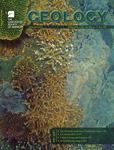How was the Iapetus Ocean infected with subduction?
+ Author Affiliations
Abstract
Because subduction in the Iapetus Ocean began only ∼35 m.y. after the end of rifting, spontaneous foundering of mature passive margins is an unlikely subduction-initiation mechanism. Subduction is more likely to have entered the Iapetus from the boundary with the external paleo-Pacific, similar to the incursion of the Scotia, Caribbean, and Gibraltar arcs into the modern Atlantic. The subduction zone probably became sinuous, entraining fragments of the Gondwanan margin along its complex sinistral southern boundary where oblique collision caused Monian-Penobscottian deformation. Following Taconian-Grampian collision of part of the subduction system with Laurentia, remaining parts of the Iapetus were progressively infected with subduction, leading to Silurian closure.
- Received 18 August 2014.
- Revision received 9 September 2014.
- Accepted 11 September 2014.
- © 2014 Geological Society of America














